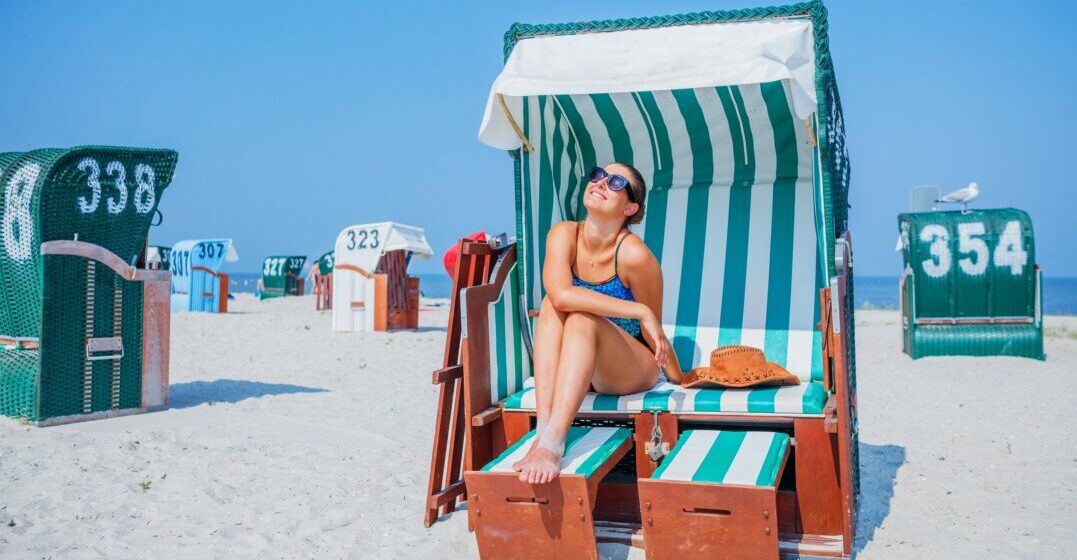The 5 best German beaches for a getaway
Published on June 3, 2022 / Updated on January 9, 2024
As a largely landlocked country, Germany isn’t generally considered Europe’s go-to seaside holiday destination. Nevertheless, Germany’s coastline extends over 2300 km on the North and Baltic Seas, boasting some great sandy locations to visit this summer. Although Germany’s Riviera may not have all the prestige and glamor of its French neighbors, there is plenty of old world charm to be found on its many beautiful beaches and in its coastal towns. So roll up your beach towel and swimming gear, grab your goggles and get yourself ready for a perfect weekend of fun, sun and surf.
Rügen on the Baltic coast, is the largest of Germany’s islands, and with miles upon miles of sandy beaches, beautiful coves and the white chalk cliffs of Jasmund National Park. Reminiscent of the coast of Dover, it truly is a must-visit holiday destination. The island is an ideal site for water sports and, if you wish to take a dive into German Freikörperkultur (FKK or ‘free body culture’), there are several nudist beaches to choose from. If water sports don’t float your boat, Rügen is also a beautiful getaway for cycling, golfing and horse riding near its scenic coastline. From mainland Germany you can get to the island by car via the Rügen bridge or the old Rügendamm from Stralsund, or take the popular Stahlbrode-Glewitz ferry.
Northwest of Rostock, on Germany’s Baltic Sea coast, you can find the traditional German spa town of Kühlungsborn, which is renowned for the picturesque Seebrücke Kühlungsborn pier and its miles of sandy beach. Kühlungsborn has been a popular resort for over 150 years and for good reason. Here you can take a stroll along the Ostseeallee promenade, which is lined with beautiful early twentieth century villas, enjoy some swimming or sailing or perhaps take a hike inland to climb the Diedrichshagener Mountain. If hiking or cycling is not your cup of tea, you can also get around with the historic Molli steam railway.
Sylt is a long narrow island in the North Sea off the northwest coast of Schleswig-Holstein near the Danish border. It’s a picturesque holiday destination known for its pristine beaches, lovely thatched houses, dune landscape and the Wadden Sea mudflats on the eastern side, where you can take a guided mudflat hike. For the Badegast or Kurgast (bathing guest or spa guest) it offers 40 kilometers of sandy beaches, sailing and windsurfing opportunities, an aquarium, an adventure center, golf courses and plenty of seasonal activities. More than half the island is a protected wildlife and nature sanctuary. Tourists may only camp on the designated sites, which must be booked in advance. Sylt has become a resort for Germany’s jet set and many tourists wishing to catch a glimpse of celebrities go there.
Föhr is the second-largest of Germany’s North Sea islands and perhaps the most beloved for beach-goers. With a mild climate warmed by the Gulf Stream, earning it the sobriquet of the “Frisian Caribbean”, its charming atmosphere and local hospitality are well-renowned. Alongside the sandy white beaches and rolling green marshlands, some of the sights to take in during your stay include medieval churches and windmills, as well as the quaint Frisian houses and cafes. Located within the Schleswig-Holstein Wadden Sea National Park, Föhr is also a wonderful place to feel close to nature and observe the local wildlife, particularly its seabirds and seals.
Nestled amongst the East Frisian Islands, Langeoog (literally ‘Long Island’ in low German) has been popular as a wellness retreat since the mid 19th century due to its fresh, unpolluted air. Langeoog is a uniquely relaxing location as the entire island is completely car-free, making it the perfect holiday escape for stressed city-folk. While the island is small enough to walk from end to end in an afternoon, if you want an easier ride, you can rent a bicycle or, better still, enjoy a horse and carriage taxi ride.
Now that you know the key spots on the German coast you can pack your bags, book a hotel and rent yourself a Strandkorb (the famous wicker beach chairs) to get the most out of some of Germany’s best beaches. Even if you don’t have time to make a trip to the Baltic or North Sea, you can always explore Germany’s Freibäder (open-air swimming pools) or the sandy beach fronts on the many lakes dotted across the country. So wherever you are in Germany you’ll have plenty of opportunities to feel the water on your skin and sand between your toes this summer.
